A Journey to A Better Me 2018
Learning by Doing
From July 14 to August 6, 2018, 22 students and 3 teachers from the School of Management Science and Real Estate of Chongqing University was on a 24-day academic visit to the Netherlands and Germany. Thanks to the substantial support and guidance of the Office of International Affairs and the Faculty of Built Environment, the academic visit to the Netherlands and Germany proved to be fruitful.
During the 24 days, teacher and students visited reputable colleges, universities, construction enterprises, construction sites, environmental protection facilities and projects, and urban renewal projects in the Netherlands and Germany. By participating in course learning, student interaction and discussion, field visit and cultural experience, the students got to know the excellent qualities and advanced practices of the West from the perspective of specialization and humanistic care. Besides, students gained a deep insight into how we should properly handle the symbiotic development relationship among the environment, the city, industry and people in the process of planning, construction and project management of a city. The rich course content during the academic visit was closely associated with specialties of the students. The field visit proved to be successful in the following ways:
I. The academic visit was professional learning-oriented and focused on the current hot topics, to broaden student's knowledge in an all-round manner.
The program courses for the students included the following learning content as determined based on the topics with special research interest, such as urbanization, urban renewal, building informatization, green building and sustainable construction:
Delft University of Technology---Sustainable Housing from a European Perspective
2018 ISARC---The Future of Building Things
Ruhr University of Bochum---Application of BIM/AR/VR in building construction; urban environmental protection transformation (construction sites)
RWTH Aachen University--Urbanization and urban planning and renewal
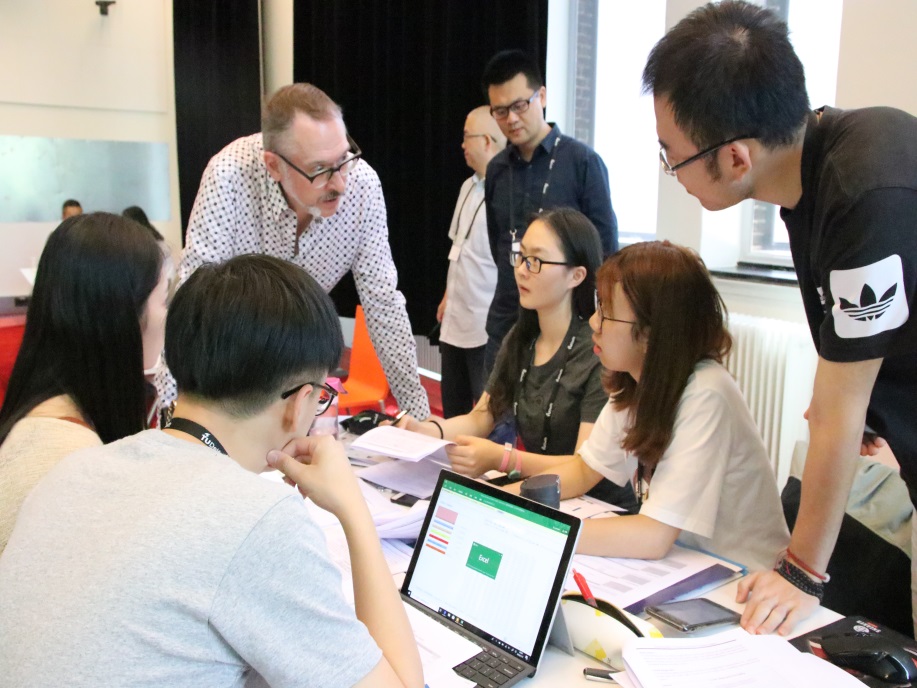
Classroom learning and discussion
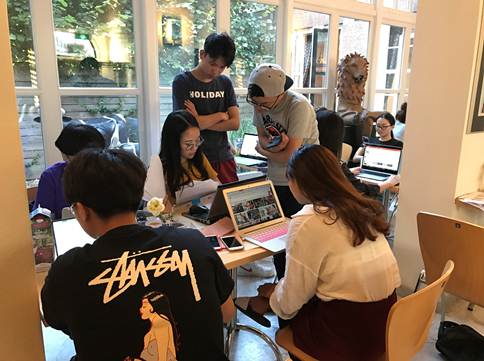
Design competition preparation
Delft University of Technology is a university of science and engineering with the longest history, largest scale and most complete disciplines in the Netherlands. Disciplines of Delft University of Technology, a world top 100 university, almost extend to all engineering science fields. It is widely known for its high-quality teaching and remarkable scientific research level. In particular, its advantageous disciplines like aviation engineering, electronic engineering, hydraulic engineering, chemical engineering, and civil engineering are enjoying a very good reputation in the world. Students of the the School Management Science and Real Estate participated in a learning program offered by the School of Architecture of Delft University of Technology. The course and lecture contents include: European and Dutch policies and regulations for energy efficient policies, the changing role of housing in societies, 2ndSkin Deep Retrofit – Building Technologies Accelerator, Assessing Sustainability: Energy and Environmental Impacts, Delivering green buildings: assessing barriers and transaction costs, Sustainable renovation: clients and supply-chain, and Management of achieving high energy efficiency. In order to consolidate the understanding of students and promote the application of knowledge, the University organized the Tender Game activity for students, in which students were asked to achieve flat energy consumption of building through proper planning and design. Students were actively involved in the activity and remain enthusiastic throughout the process. After the class, students volunteered to continue the discussion in the hotel room and tried their best to achieve satisfactory results drawing on the knowledge they learned.
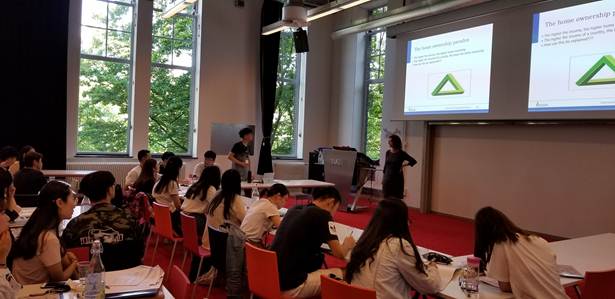
Classroom teaching
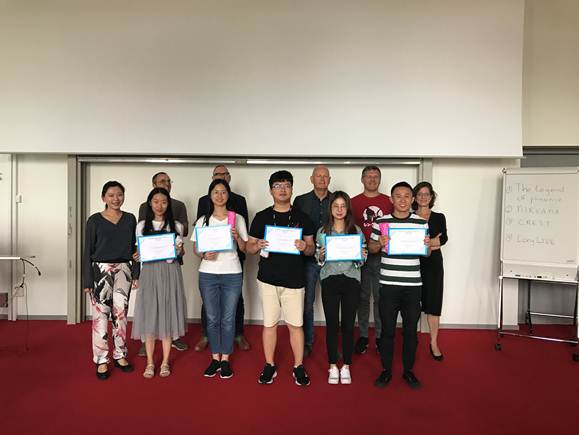
Certificate Awarding
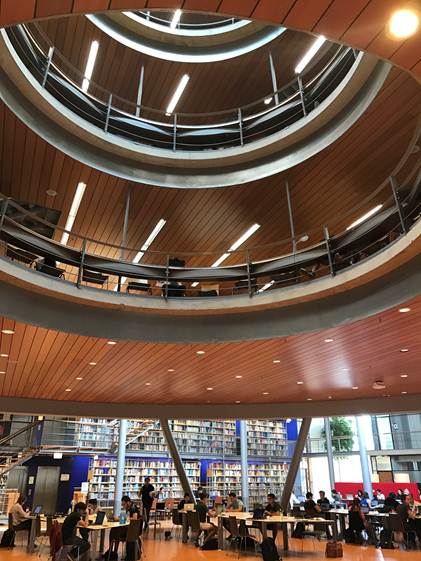
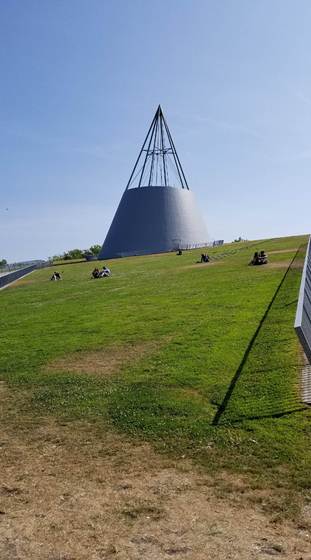
Interior and exterior of the library of Delft University of Technology
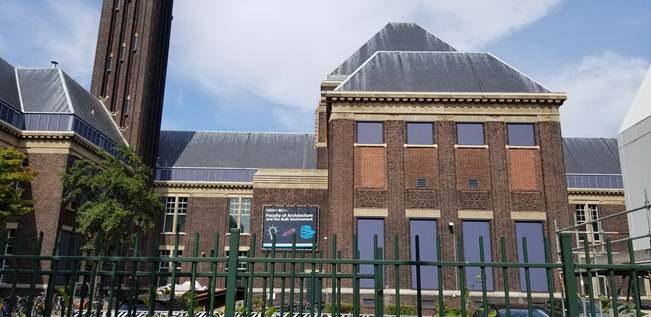
The School of Architecture and Built Environment of Delft University of Technology
Ruhr University of Bochum is a large-scale comprehensive university. In recent years, the University has been concentrating efforts on enhancing its leading role in academic research field, and ascended to the second place in the DFG ranking. The students were filled with wonder when they saw the complete teaching and living facilities and rich resources provided for the students the moment they arrived at the campus. Students and teachers learned the application of BIM, VR/AR in design and construction, and, guided by teachers and students of Ruhr University of Bochum, built a BIM model and experienced the technological application of AR/VR in the laboratory.
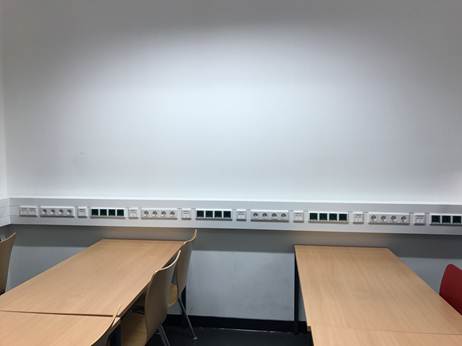
Plenty of power outlets in the classroom for students to use
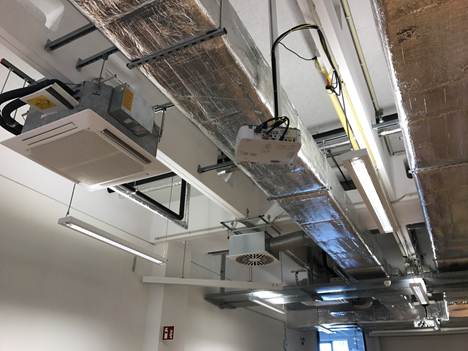
Two projectors are provided, one in the front and one in the rear, to meet the needs of students in the back rows.
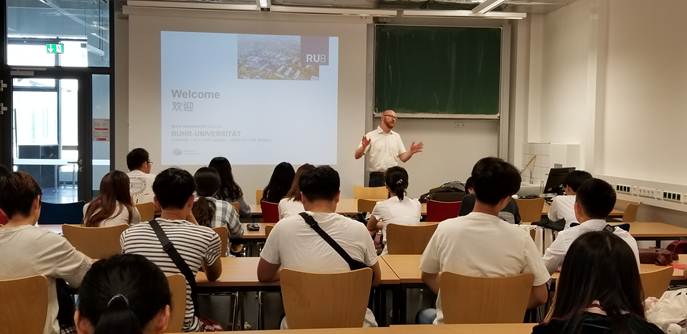
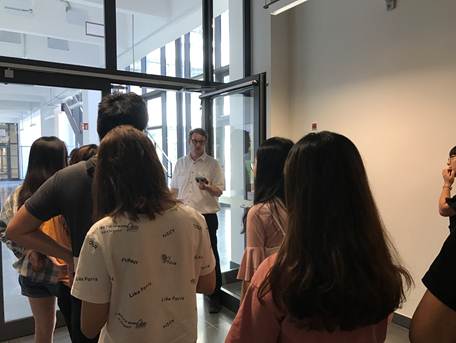
Course learning
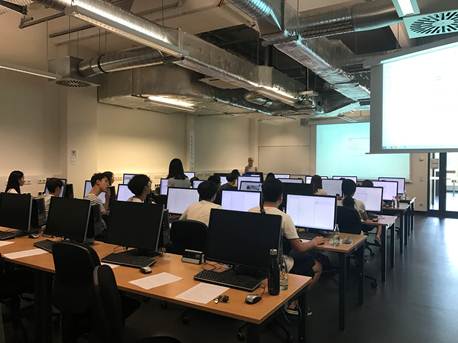
BIM model practice in the laboratory
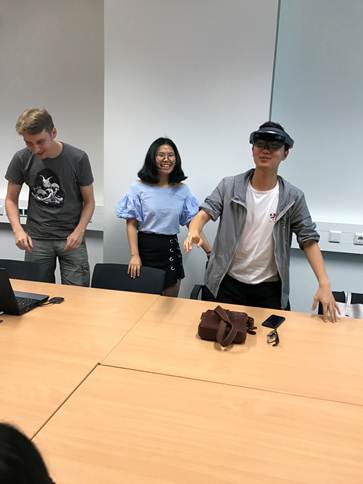
AR/VR experiment
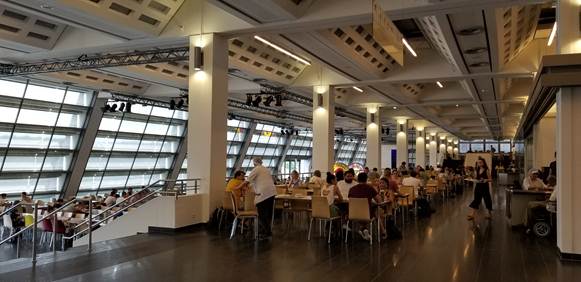
Student canteen
\The full name of RWTH Aachen University is Rheinisch-Westfaelische Technische Hochschule Aachen, and its short name is RWTH-Aachen. Founded in 1870, it is a member of various international top academic alliances, one of the most well-known university of science and technology in Germany, and one of the world top university of science and technology. At the Department of Real Estate of the School of Architecture of RWTH Aachen University, Professor Elisabeth explained related knowledge of real estate to students, gave an analysis of the purpose and function of real estate, as well as the life contour of real estate. Mr. Peter from the Department of International Exchange of the University, who was in Tang suit, explained in details the cooperation in joint talent nurturing between RWTH Aachen and colleges and universities in China, as well as the University's exchange policy for Chinese students. Through visit to project sites, the students gained a profound understanding of how Germany made long-term and thorough planning in urbanization in the process of the urban renewal and re-development and urban rehabilitation from perspectives like the city and humanity. They visited communities and carried out field surveys and opinion surveys to ensure trouble-free and satisfactory implementation of the urban rehabilitation and renewal plan, which aimed to attract talents, boost development of industry, improve ecological environment and enhance people's quality of life. This is what we should think on and learn from. After that, students and teachers visited a number of important experiments conducted by the Department of Water Resources and Hydropower Engineering of the University, including gravity dam discharge experiment, gravity dam static experiment, flood discharge and energy dissipation and downstream anti-scour experiment, penstock water hammer experiment (unstable flow or transition process), surge chamber hydraulics experiment, turbine efficiency experiment and demonstration experiment of several water conservancy and hydropower engineering simulation models. These experiments covered various research topics of students, such as the impact of water pressure on fish, and impact of water pressure on materials. These demonstrated the scientific research strength and capacity of the University. Hospital of RWTH Aachen University is one of the largest and most well-known hospitals in Europe that integrates features like teaching, hospital practice, management and enterprise science and technology. It is located at the junction of 3 countries, i.e., Germany, Belgium and the Netherlands. The Medical Center is located out of the downtown but it takes only 10 minutes by car to get to the Hospital from the downtown.
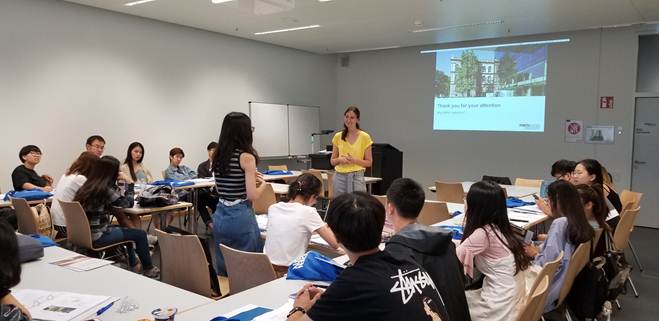
Classroom learning at RWTH Aachen University
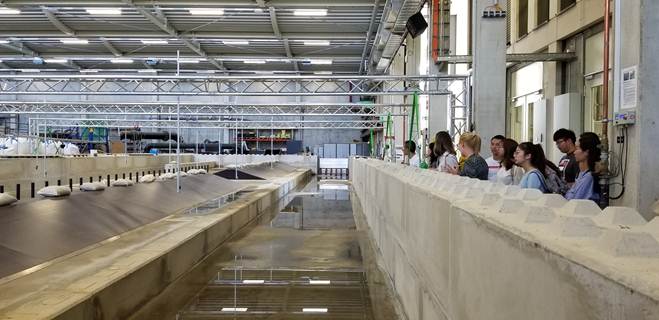
Students are on a visit to the laboratory of RWTH Aachen University
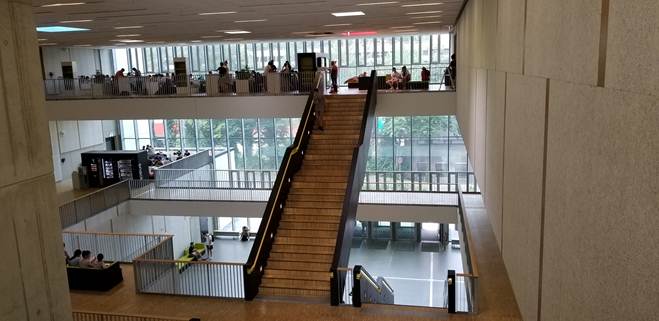
A corner of the Teaching Building of RWTH Aachen University
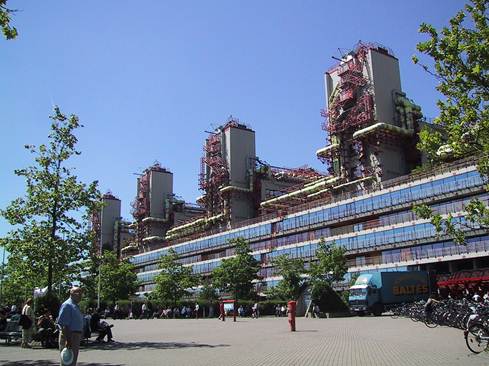
Hospital of RWTH Aachen University
The 35th International Symposium on Automation and Robotics in Construction (ISARC), organized by IAARC, was being held in Berlin from July 20 to 25. IAARC is a world-leading organization of professionals and researchers engaged in architecture, engineering, construction and facility management (AEC/FM). They hold that practice, education and research of automation and robotics in construction must be changed to cope with the existing and future challenges facing the world. Historically, world top researchers already turned the International Association for Automation and Robotics in Construction (IAARC) into the most important international organization in the world in 1990. ISARC has been an annual flagship event of IAARC Since 1984. It is an event for employees, researchers, and industrial and academic leaders in the sector. The event this year was organized by Technische Universitaet Berlin and Ruhr University Bochum and included 1 main session and 3 parallel sessions on different academic topics, which were held synchronously. Researchers at the event shared their research findings and experience in 9 topics, including BIM, security, construction management, deep learning perspective, infrastructure management, automation/robotics, machine learning, computer perspective, and Internet of Things.
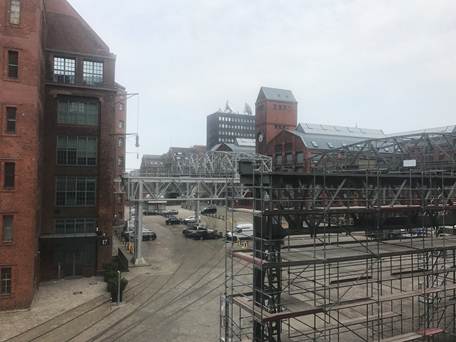
A corner of Technische Universitaet Berlin
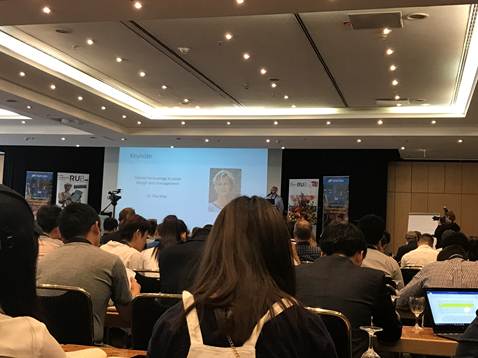
2018 ISARC
II. Field visit and hands-on practice
“Reading ten thousand books, traveling ten thousand miles”. During the academic visit, besides course learning, students and teachers of the School of Management Science and Real Estate also visited the energy-saving reform project of public renting houses in Rotterdam, the urban re-development of Amsterdam, energy-saving project of Delft, a construction site in Berlin, water treatment facility construction site in Bochum, urban rehabilitation planning project of Monchengladbach and HUF HAUS prefabricated vila project, and gained deep insights into the objectivity, rigorousness, teamwork, willingness to share and humanistic care as demonstrated in their altitude towards work and life and development.
● Energy-saving reform project of public renting houses in Rotterdam
At the site of energy-saving reform project of public renting houses in Rotterdam, students noticed that there was no flying dust. Owners could still live in the houses without being interfered with or suffering from any pollution. Teachers and students visited a number of households there to know more about the contents of the reform project. During the visit, a resident who had lived there for 20 years explained the reform project to the students and answered questions raised by students with patients, including government policy, rent rate, building materials, apportion of reform expenses and living experience. After that, students visited the exhibition hall of energy-saving materials and products, and got to know the energy-saving products commercially available to enterprises and households.
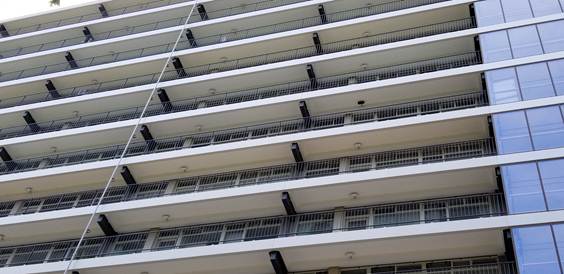
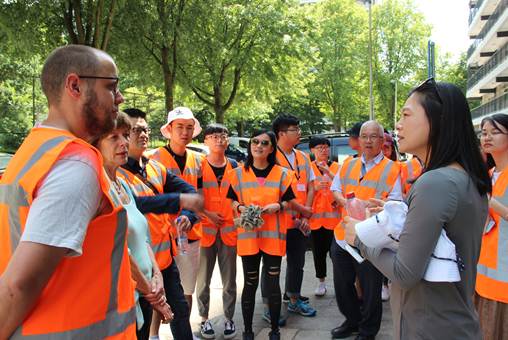
Energy-saving reform project of public renting houses
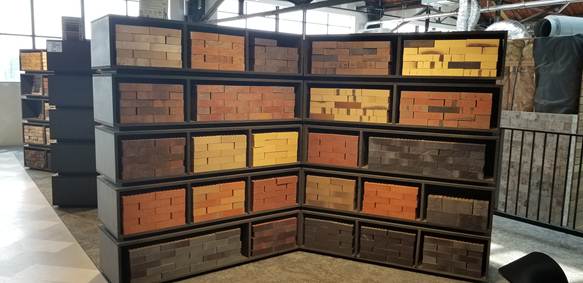
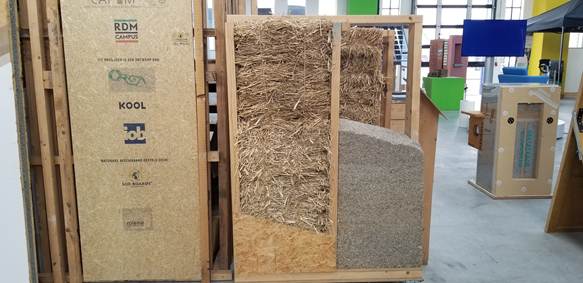
Energy-saving and environment-friendly materials
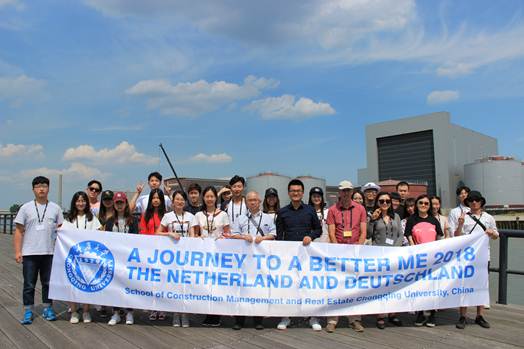
Group photo
● Urban development project of Amsterdam
The students visited urban re-development sites of Amsterdam, including coast of Amsterdam, East Port Area (reclamation) and Zuidas. The main purpose of the field visit is to let the students see the modern real estate development in Amsterdam. Development in the downtown of Amsterdam is quite limited. In order to cope with the pressure of the housing market, the municipal authorities and investors had to find new development sites to boost economic development and improve people's living standard. The coast of Amsterdam is a public residential complex, which is the result of progressive planning and reconstruction efforts of the municipal authorities and private organizations in the 1990s. The East Port Area is a place that was once abandoned by shipping companies. Now it has become a successful example of real estate development targeted at people with medium and high income. Zuidas (south axis) is a new development site that aims to expand Amsterdam as an international finance center.
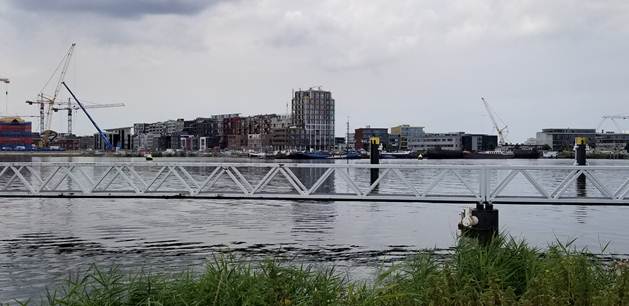
An overview of the new development areas
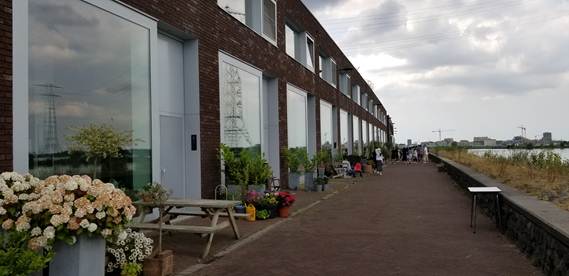
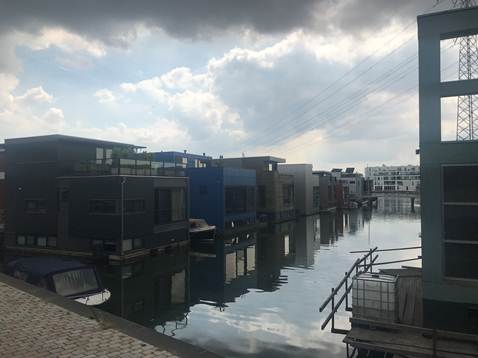
Students are on a visit to the site of a real estate development project.
● Green city project of Delft
Technische Universiteit Delft organized a bicycle trip for the visiting delegation. Led by the accompanying professor, the delegation visited the energy-saving experiment house, green residential area and settlement buildings in succession, and got to know about the development and change of this city. The energy-saving experiment houses acquire natural resources with the use of solar panel and geo-thermal pumps, and are green and environment-friendly. Lighting in the houses is a combination of natural lighting and artificial lighting. Solar panels on the wide French window automatically get erected to serve as a sunshade while capturing solar power when there is direct sunlight. Rainwater collecting facilities are provided on the roof of the sunlight room. The rainwater collected is mainly used for watering green plants and is not drinkable. Fountains, flowers and green color were what caught the students the moment they walked into the green residential area. Green plants were seen attached to many buildings. They could reduce direct sunlight, lower indoor temperature and reduce energy consumption in summer. The extensive use of prefabricated buildings did not only save project cost and time, and reduced environmental impact and other troubles resulting from onsite construction.
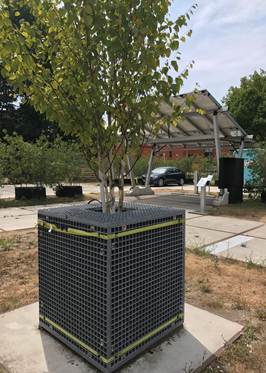
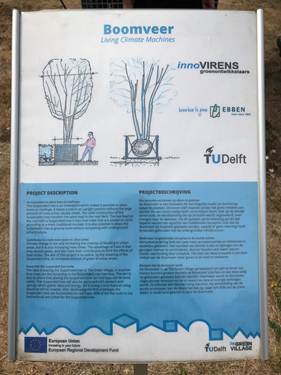
A visit to the energy-saving experiment site.
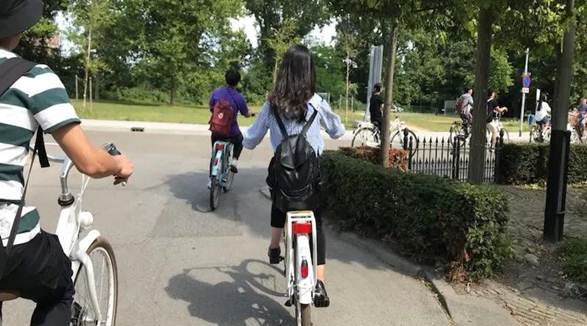
The bicycle tour
● Use of information technology in project construction
In Berlin, according to the topics of this year's ISARC, the organizers, Technische Universitaet Berlin and Ruhr University Bochum, made arrangement for field visit to construction sites of commercial and residential building projects. The project director explained to the students how BIM and other information technologies were used from design to construction and then to subsequent maintenance, and how they attached equal importance to efficiency, quality and safety management during onsite management.
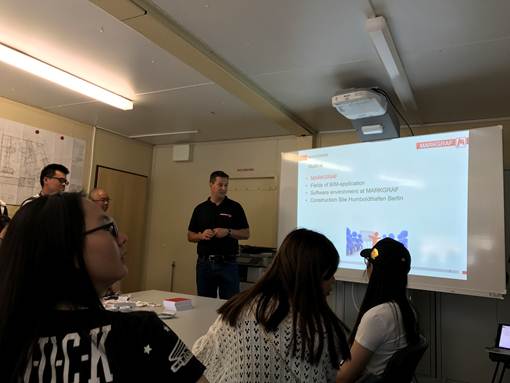
Project overview
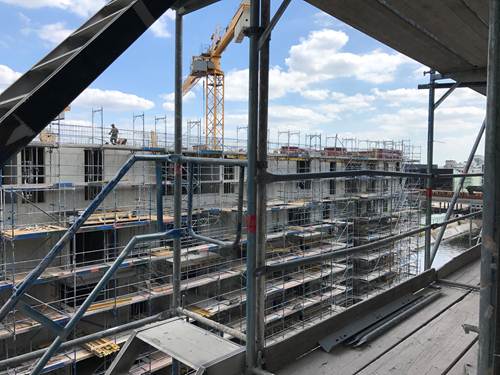
Project site (clean and high-quality scaffold)
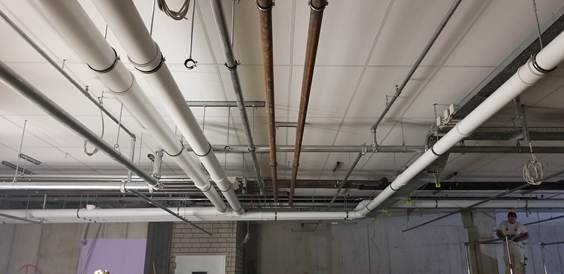
Pipes
● Examples of transformation development of Ruhr region in Germany
As invited by Ruhr University Bochum, students and teachers visited the water treatment facility construction site. It is not only a construction site. It is a typical example of how Ruhr Industrial Base went through its industrial transformation and restored beauty of the natural environment by shutting down coal mines, governing the environment and developing innovation industry. It is of great referential value to China that is currently facing the same dilemma. Ruhr Industrial Base is a world renowned industrial base with a long history, and is regarded as a miniature of industrial civilization. Ruhr Industrial Base is located within North Rhine-Westfalen of Germany, right between the River Ruhr and the River Lippe, both of which are tributary of the River Rhine. The Industrial Base covers an area of more than 4,400 square meters and has a population of more than 5 million. In history, Ruhr Industrial Base was known for its coal, steel and chemical industries, and much-maligned for the environmental pollution, ecological damage and deterioration in residents' life quality it caused. But when the students and teachers arrived at the Base, they were amazed to find that the air quality there was good and green lands and parts could be seen everywhere. The River Ruhr, once dubbed as "cocktail" due to its serious contamination, has now become a popular tourist attraction. According to the project director, in the 1950s and the 1960s, men living in Ruhr region had to change their shirt everyday, and dust would accumulate very quickly on the window sill. Now, the traditional industries have faded out. The ecological environment of Ruhr region has recovered to a desirable level. The local government initiated diversified economic development 10 years ago, and since then health economy became an important industry of Bochum. Information security industry will be playing an important role as well. The goal of Bochum is to become the capital of information security industry of Germany. This construction project of water treatment facility is part of the reconstruction of ecological environment surrounding the water body and water treatment that aims to further improve the ecological environment, and is winning support of the government, related institutions and the public.
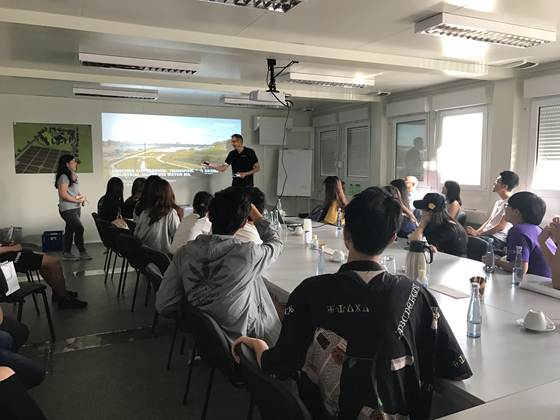
History of the water treatment facility project
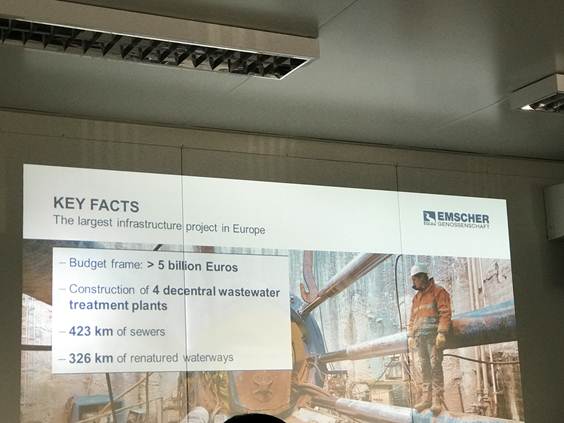
Overview of the water treatment facility project
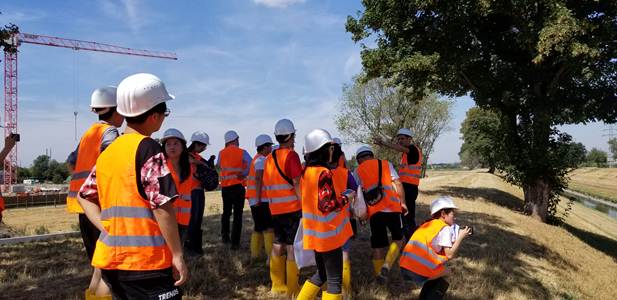
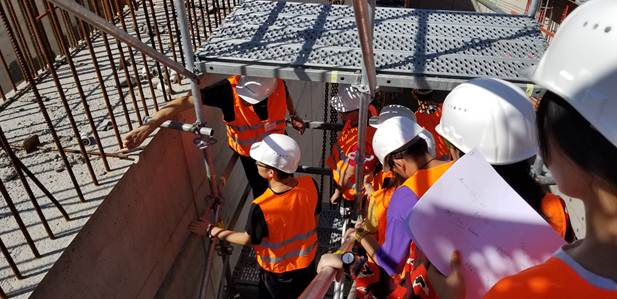
Students are on a visit to the water treatment facility project
● Urban rehabilitation planning of Monchengladbach
As invited by RWTH Aachen University, the teachers and students visited Monchengladbach. Deputy director of the Development Bureau of Monchengladbach and his companions introduced to the teachers and students the development history, development ideas, urban planning and specific measures of Monchengladbach. It is a city located to the west of Dusseldorf , the capital city of North Rhine-Westfalen of Germany. It is a well-known center of textile industry and garment manufacturing industry and is also where the National Textile Industry Research Institute is located. While concentrating efforts on development of competitive industries, Monchengladbach is trying innovative approaches to attract enterprises and investors of other industries, and develop sports facilities, improve the cultural environment and improve the inherent competitiveness of the city, with an ultimate goal of attracting and retaining talents. It is of enlightening significance to China, which is currently going through rapid urbanization. After that, workers of the Development Bureau and accompanying professor led the students to renewal sites of Monchengladbach. The students were greatly impressed by the broadened roads, hand-painted graffiti on old buildings, and church parts hidden in the forest that demonstrated the great development potential and vitality of the city.
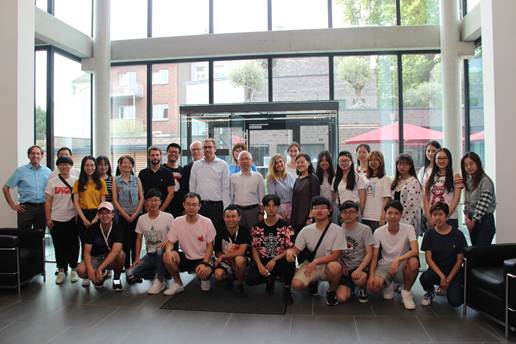
A representative of the Development Bureau is introducing the renewal planning.
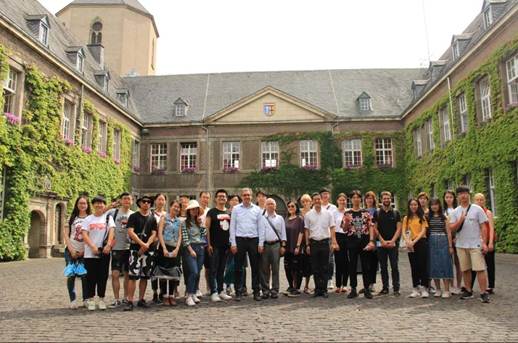
The students are on a visit to renewal planning project sites of Monchengladbach.
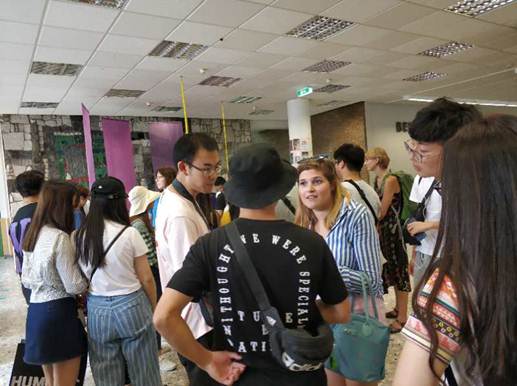
Questions & Answers
● Prefabrication-A visit to HUF HAUS
HUF HAUS was founded in 1912, and is now one of the most renowned German suppliers of prefabricated luxury villas. It has completed more than 10,000 projects all over the world. The prefabricated buildings promoted by HUF HAUS are built in an industrialized production approach, in which all or part of the components of the building are prefabricated in the factory, and then transported to the construction site, and assembled into a building by reliable connection means. There are different types of customized sample villas of various styles, appearances and interior decorations. By visiting the finished prefabricated villas of various styles, students gained a deep understanding of the advanced and user-friendly design and lean manufacturing concept of Germans.
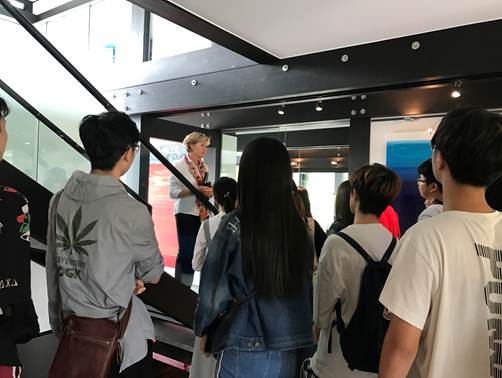
A field visit to samples of prefabricated villa
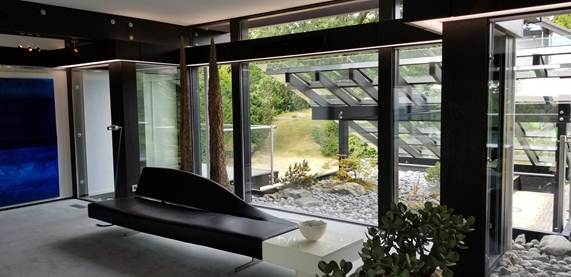
Appearance of the samples of prefabricated villa

Interior of the samples of prefabricated villa

A group picture taken during the field visit
III. City tour and cultural impression
● The Hague
The first stop of the unforgettable journey to the Netherlands and Germany was the Hague. The Hague (in Dutch: Den Haag) is located in South Holland and is the capital city of this province. It is the third biggest city of the Netherlands after Amsterdam and Rotterdam. As the seat of the central government of the Netherlands, it is also where Beatrice, the Queen of the Netherlands, works and lives. All the government organs and embassies of different countries were also set up here. To demonstrate democracy and political transparency, the central government of the Netherlands made the wall of the office building on the side close to the street as glass curtain wall, so that people can see the civil servants in the building handling office affairs and attending meetings, or even arguing fiercely with each other. The Prime Minister of the Netherlands stays close to its people. On working days, people can see the Prime Minister go to work or go home from work by bicycle.
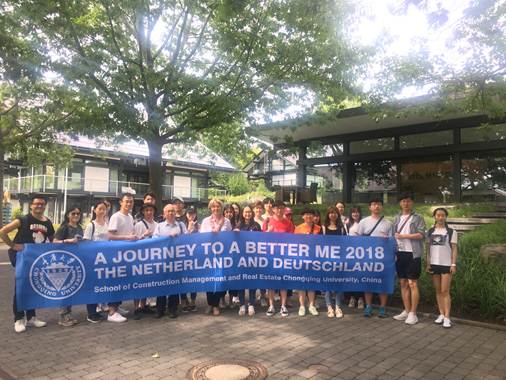
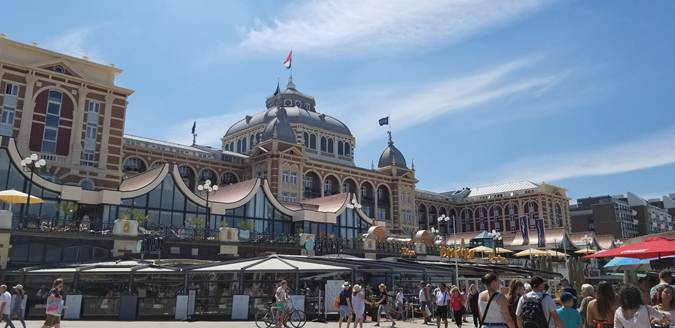
A corner of the Hague
The Hague was unusually quiet on weekends. Sometimes a tramcar passed by and the driver would say hello to the teachers and students. Flocks of birds and herons by the pond were so lovely. The old buildings and weathered copper statues on the two sides of the street made a perfect match. It was right on the morning of Sunday and there was a flea fair. The students were impressed by the dazzling array of beautiful articles on sell. The Hague, a city full of historic deposits and vitality, is opening its arms to visitors from all over the world.
● Amsterdam, the Netherlands
The Amstel River is the birthplace of Amsterdam. Amsterdam originally referred to the dam of the Amstel River. In the golden age of the Netherlands, Amsterdam grew rapidly into a finance and diamond center, and has now become a city of world renown. The main purpose of the field visit is to let the students see the modern real estate development in Amsterdam. Development in the downtown of Amsterdam is quite limited. In order to cope with the pressure of the housing market, the municipal authorities and investors had to find new development sites to boost economic development and improve people's living standard. After the visit, the teacher and students went to the well-known central station of Amsterdam. Ambling along the busy street, threading your way among the crowd of people, you will feel like part of the city. The art performances at the square, the white pigeons that can be seen everywhere, the little-known artists playing the piano at the station, and typical buildings of Europe style make up the unique memory of everyone about Amsterdam.
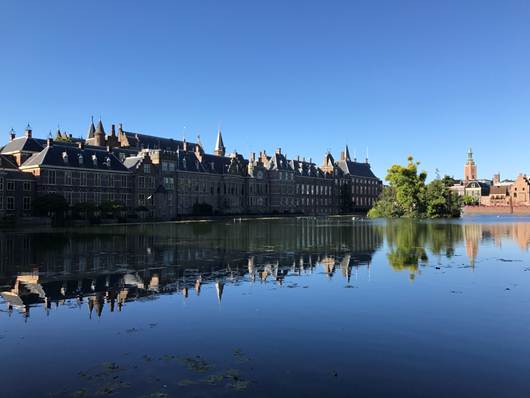
Port Area of Amsterdam
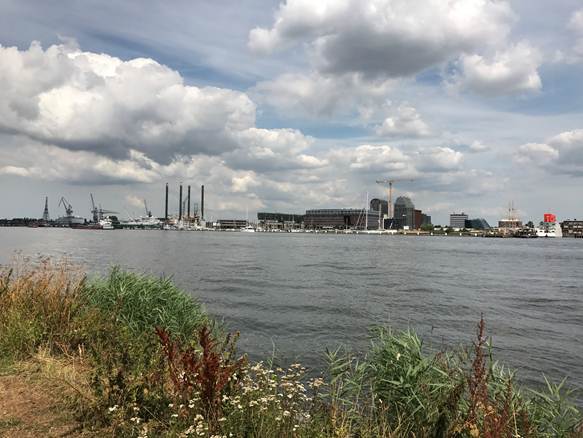
Downtown of Amsterdam
● Delft
Technische Universiteit Delft made arrangement for a bicycle trip for the delegation so that the students could have a close look at the scape of the city. Led by the accompanying professor, the delegation visited the energy-saving experiment house, green residential area and settlement buildings in succession, and got to know about the development and change of this city.
The energy-saving experiment houses acquire natural resources with the use of solar panel and geo-thermal pumps, and are green and environment-friendly. Lighting in the houses is a combination of natural lighting and artificial lighting. Solar panels on the wide French window automatically get erected to serve as a sunshade while capturing solar power when there is direct sunlight. Rainwater collecting facilities are provided on the roof of the sunlight room. The rainwater collected is mainly used for watering green plants and is not drinkable. Fountains, flowers and green color were what caught the students the moment they walked into the green residential area. Green plants were seen attached to many buildings. They could reduce direct sunlight, lower indoor temperature and reduce energy consumption in summer. The extensive use of prefabricated buildings did not only save project cost and time, and reduced environmental impact and other troubles resulting from onsite construction.
In Delft, you can see cycle tracks on the two sides of the streets. Most of the local residents prefer to travel by bicycle. As the city is not that big, this means of transportation is both effective and environment-friendly. When the students were riding a bicycle on the riverbank, they saw some giant windmills and ancient churches and were deeply impressed by the pleasant views.
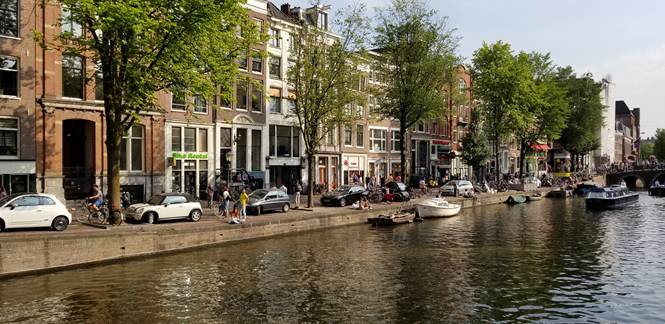
Downtown of Delft
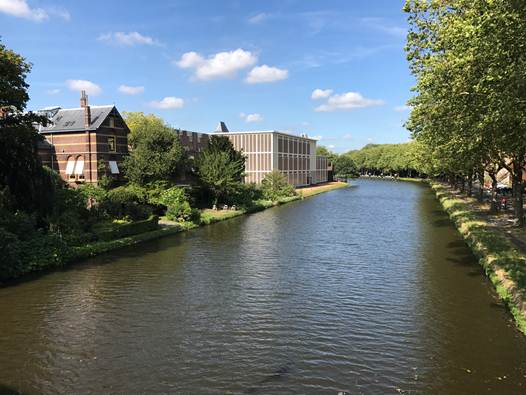
An old church in Delft
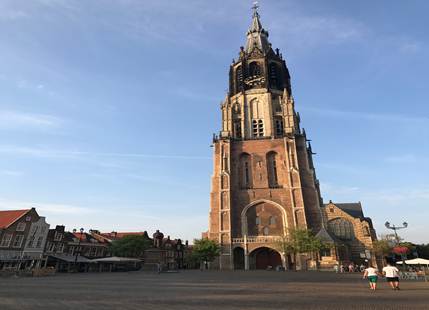
A street in Delft in the sun
● Berlin
Berlin, the capital of Germany, was the first stop of our visit to this manufacturing power. The teachers and students were lucky enough to be able to attend ISARC and visit scenic spots and historical sites such as Brandenburg Gate, Berlin Reichstag and Berlin Wall. They were amazed by the stateliness of Kingdom of Prussia during the glory days of Germany under the Brandenburg Gate and the perfect combination of high-tech approaches and traditional buildings as demonstrated by Berlin Reichstag and listened to the heavy sigh at that time by Berlin Wall. In the free time in Berlin, some of the students climbed to the top of the Berliner Dom, where they could behold the entire Berlin. Others visited Pergamum Museum to feel the profound cultural deposits. You can see the reflection of Germans on the history from the World War II museums and monuments of different sizes. If you are careful enough you will notice the detailed garbage classification practiced in Berlin, which shows the great importance this country attaches to environmental protection. At dusk, people were holding a big party by the Tiergarten Park. Despite their stereotype as being serious, Germans would indulge themselves to a leisure life in spare times like they really know the art of living.
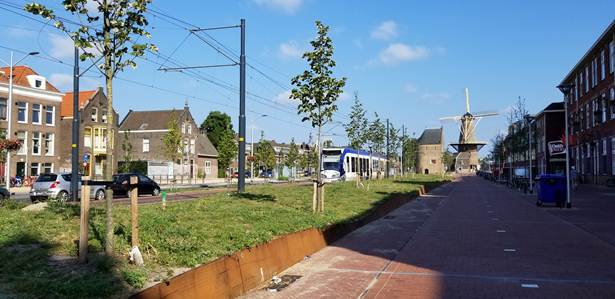
Brandenburg Gate at night
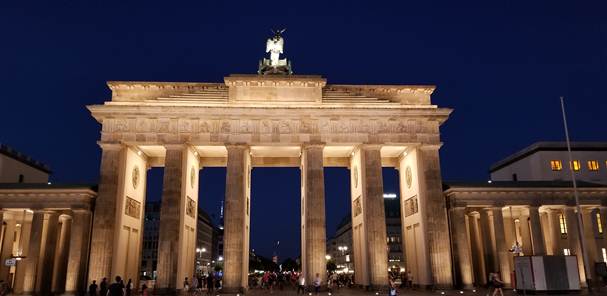
Night view of Berlin
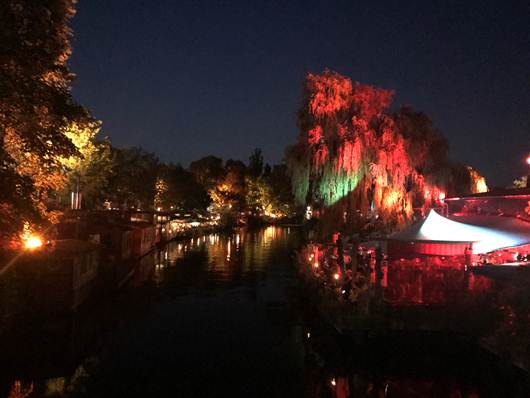
Humboldt University
● Dusseldorf
Dusseldorf (Düsseldorf in German) is located by the River Rhine. In German, Dorf means "village". For this reason, Dusseldorf is jokingly dubbed as the "largest village in Europe". It is very close to the well-known Ruhr region, and is the capital of North Rhine-Westfalen, the most densely populated and economically developed region in Europe. Furthermore, it is an important city for the advertising, clothing, exhibition and communication sectors of Germany, and a central logistics city of Europe. In the city, there are historical sites of the 13th Century through the 18th Century, art schools, and well-known Pottery Museum. It is also the birthplace of Heinrich Heine, a famous German poet in the 19th Century.
The first stop of trip to Dusseldorf was the Rhine TV Tower that is 168m tall. The Rhine TV Tower stands right by the bank of the River Rhine and is the tallest building in Dusseldorf, where you can enjoy the best views of the River Rhine. Looking down at the entire city, you will be shocked by its modernness and historical sense. You will see how the River Rhine zig-zags into the distance, and shimmers with charm in this city where no tall buildings can be found. Strolling in the old town of Dusseldorf by the Rhine River, you will see buildings of ancient German style and the quartzite pavement that make the streets of the old town very special. There are many characteristic restaurants, bars, and stores in the old town. The students were amazed by traces of diversified customs and culture that could be found everywhere.
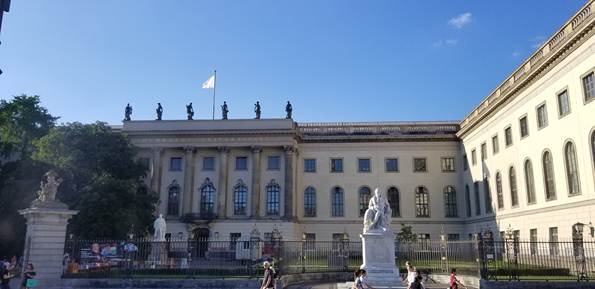
An aerial view of Dusseldorf
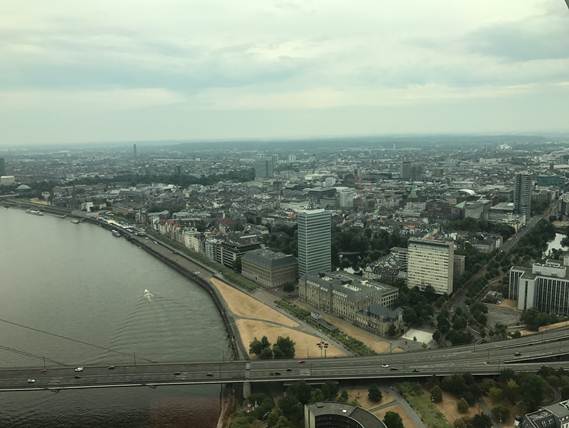
Königsallee in Dusseldorf
● Wuppertal
Wuppertal is home to Engels, and is where "aspirin" was found. It is also home to the longest suspension train rail in the world, which was completed in 1903 with a total length of more than 13 km. It is also the place where the textile industry of Germany originated. Wuppertal is located right by the River Wupper. Due to the significant altitude difference, you can find many staircases and streets with great gradients. As a result, Wuppertal becomes the city with the most public staircases in Germany. When you come here, you may feel like you are in Chongqing.
Wuppertal has the first suspension monorail train rail in the world. It has a length of 13.3 km and there are 20 stations along the line. When you get into a train from a hanging platform, and moves along the zig-zag River Wupper, it feels like you are flying low above the ground especially when a train of the opposite direction passes by. The old train would swing slightly. River water is murmuring and people are walking slowly below. This is a really special experience.
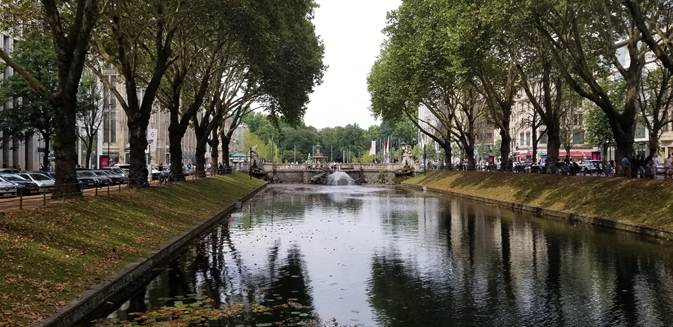
Suspension type monorail train
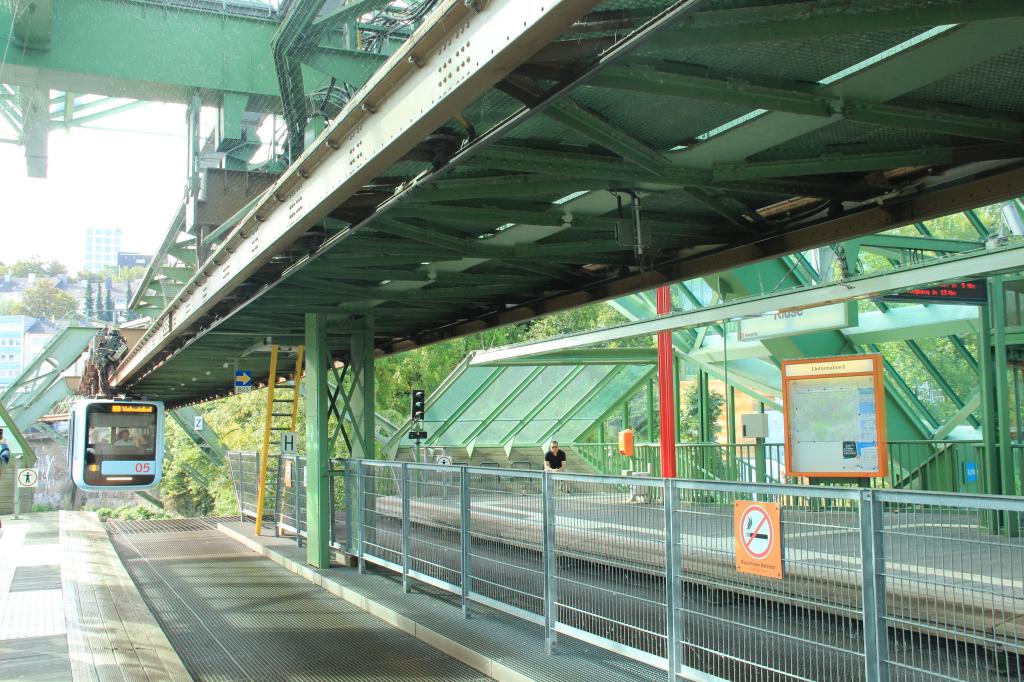
The rail is built along the river.
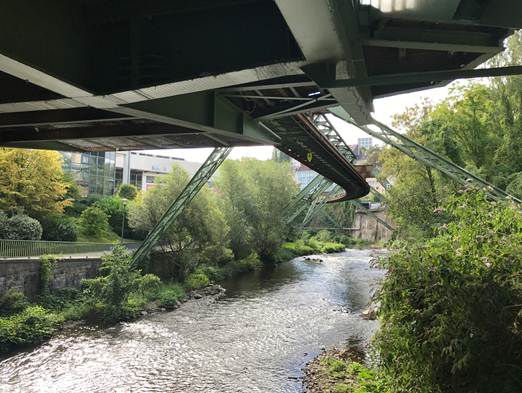
Famous Bayer Pharmaceuticals
● Aachen
Aachen is on the westernmost tip of Germany, and is right in the middle of the European Continent. Since the 1st Century BC, Romans have been using this area of hot springs. Later, a branch of Franks of the Nordic came and settled down here and named it Ahha, which means water in their language. This city is now still well-known as a wabering place. Charlemagne of the Franks liked Aachen very much, and established Aachen as the capital of the Frankish Kingdom, where he spent most of his late years. In the Middle Ages, Charlemagne ruled most parts of Europe. As the capital of the Kingdom, Aachen served as the center of its power, and is therefore called the "Cradle of Europe". Charlemagne is called the "Father of Europe".
Ambling in the old town of Aachen, you will see the Cathedral of Aachen where the remains of Charlemagne was buried; the flower booths at at the square of the Cathedral; and street artists who are playing unknown music. Trust me you would never want to leave an old town like this. As there are many Chinese students in this city, the Chinese dishes offered in Chinese restaurants here are genuine and tasty. The students and teachers were happy to find that.
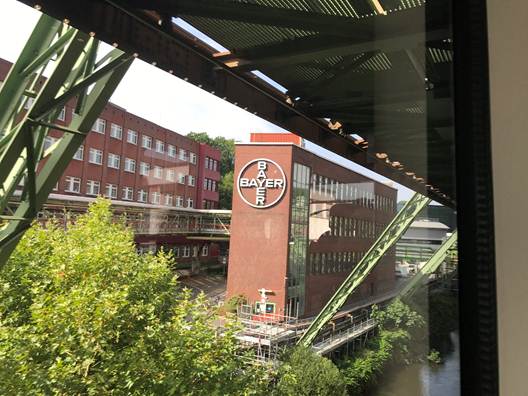
Cathedral of Aachen
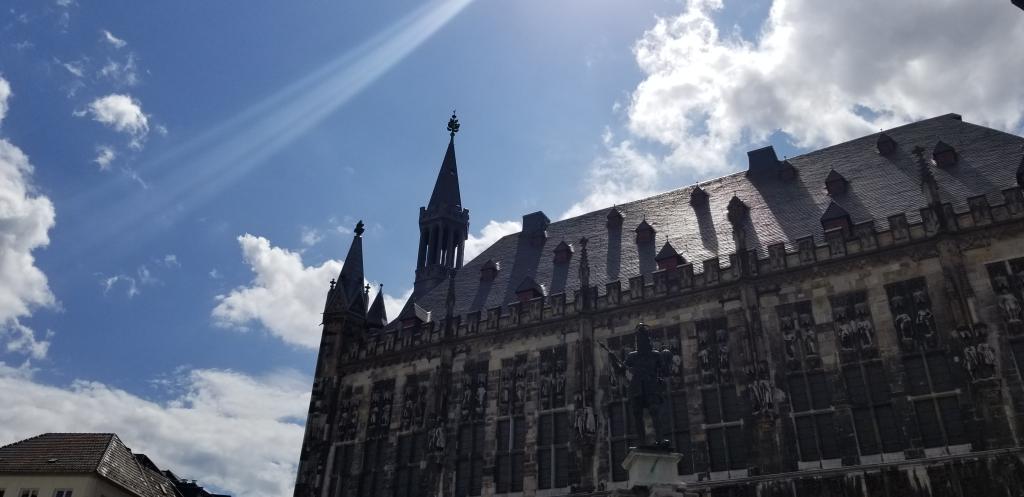
Meat dumplings in spicy sauce

Cold noodles with chicken shreds
● Cologne
Cologne is a famous historic city and heavy industry city located by the River Rhine in west Germany. Cologne is the fourth largest city of Germany after Berlin, Hamburg and Munich, and has a population of 970,000. It is a city full of modernness. It is a busy commercial city where you can see row upon row of high-rise buildings.
The first stop of our trip was Universität zu Köln, which was founded in 1388, and has a history of more than 600 years, only 2 years younger than Heidelberg University (built in 1386). It is one of the oldest universities in Europe and even the world. Accompanied by a professor of the University, we visited its teaching and scientific research facilities and got to know that the University has both arts and science disciplines but does not have any engineering disciplines. Its economics and law enjoy nationwide fame. Besides, its strength in theoretical physics, biology, medicine and other natural science areas is also remarkable. Universität zu Köln has the Department of Economics of the largest scale in Germany, and its economics and management are among the top 3 in Germany.
When talking of Cologne, people would be reminded of Cologne Cathedral. It is the third tallest church in the world, and is located right beside the beautiful River Rhine. It took more than 600 years to build this cathedral. During the World War II, Cologne was almost razed to the ground. Surprisingly, Cologne Cathedral stood still. All students and teachers were astonished by its magnificence. The moment you step into the Cologne Cathedral, you would be overwhelmed by the atmosphere of solemnity and its majesty and power. The fine wall paintings and suspended ceiling are also impressive. Looking up, you would see a tower top high above, which symbolizes the close contact between the church and God. Inside the church, there are crowds of praying believers. You may also climb to the top of the tower and enjoy the whole scene of Cologne and see the layout of the city.
Close to the Cologne Cathedral is Ludwig Museum. Ludwig Museum is a building of modern style with a serrated roof, and looks totally different from the adjacent Cathedral and train station. Ludwig Museum was built in 1976 and has a collection of 774 pieces of works of Picasso. Besides, it also houses a great mount of modern artistic works and photography works. The students visited the Museum and got to know the stories of the life of Picasso, and his unique academic style, primitive art, cubism and surrealism as demonstrated in his works. Students said that they were greatly amazed by the exquisiteness of the modern artistic works and the vividness of the photography works.
Moreover, food of Cologne is tasty yet inexpensive. Here you could find German elbow, sausage and other novel food. Sitting in a cozy and quiet restaurant with your friends, and enjoying the pleasant scenery of Cologne, it just takes a glass of beer to spend a nice afternoon.

Group photo
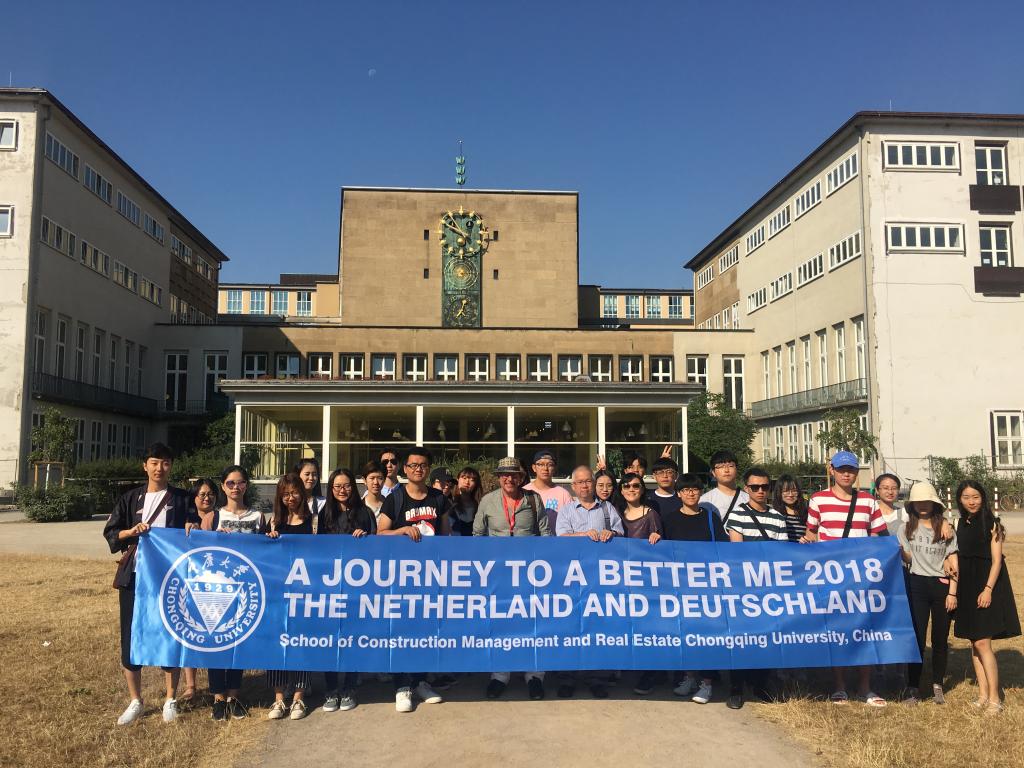
Ludwig Museum
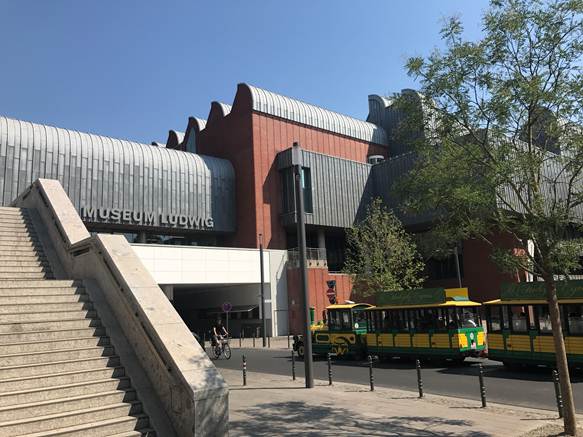
Cologne Cathedral
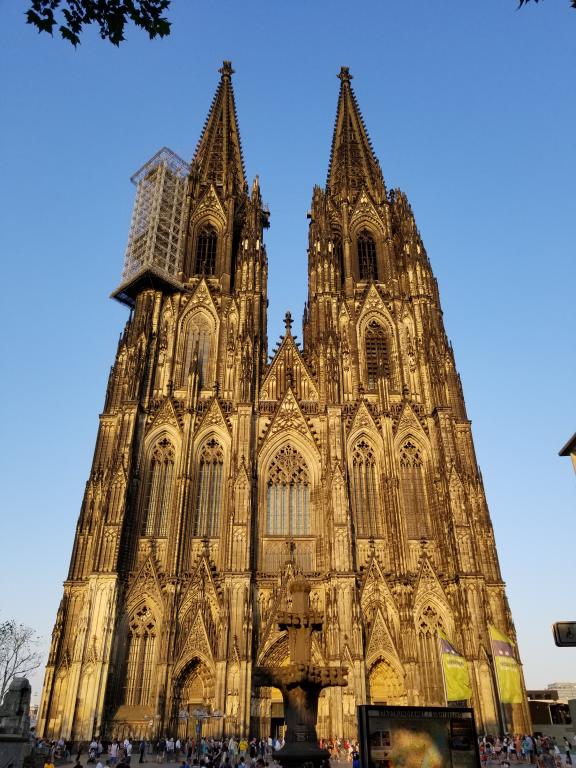
Cologne Train Station
IV. Broadening horizon
During the 24-day visit, students felt the sincerity, enthusiasm and equality of Europeans, and experienced the uniqueness of Europe in aspects including food, clothing, shelter and means of traveling. What impressed the students the most is the fact that the happiness of European people does not only come from material exquisiteness and elegance, but also come from their spiritual equality, freedom, openness, carefulness, rigorousness and perseverance. What ever job you do, everyone is equal and proud of their job and life.
During this trip the students found that most of the expressways in Germany did not have a speed limit and surprisingly there were very few accidents. Reasons are many. Germany has a complete set of national technical standards, and poses very strict requirements on construction quality of roads. The road surfaces are even, with proper roughness, are suitable for safe and fast driving. Besides, road markings and signboards on the highways are simple and straightforward, without a single unnecessary word. Along expressways there are emergency phones, broadcasting equipment, TV surveillance and facilities for automatic recording and adjustment of traffic volumes. Complete service facilities, such as gas stations, parking lot, restaurants and motels, are provided at regular intervals along the expressways. The manufacturing quality of automobiles is strictly controlled. Moreover, Germany has a strict driving test system, and driving test in Germany is notoriously expensive and difficult. The average cost for an individual to get a driving license is about 1,500 Euros, and very few get to pass the test at the first attempt. You will fail the road test even if you only make a small mistake. These all come down to the "rigorousness" of the German people, and their strong "safety consciousness". The "small mistakes" are generally attributable to inadequate safety consciousness, rather than poor driving skills. German drivers have very strong sense of order and legal consciousness, and will take a rest as required. Besides, vehicles on the expressways will follow the specified route and lanes and there are very few occasions where the overtaking lane is occupied for a long time or a car overtakes another on the right.
During the 24-day academic visit, the 25 teachers and students were serious about every chance they got to learn and experience. Particularly, they were active in sharing ideas and asking questions over discussions, and teachers and seniors from colleges, universities and enterprises from other countries were impressed by the curious and professional attitude of Chinese students. Through the academic visit, the students broadened their knowledge and realized what came short in themselves and the overall development of the city.
After talking to the students, we found that the design and arrangement of the program could be more systematic, detailed and specific, so that the students have a better understanding of the goals and purpose of the academic visit. More importance should have been attached to the interpretation of the program contents during the training before the visit, so that the students could have a rough idea of what they were going to learn. The arrangement in terms of the order of countries and time could be more diversified and flexible.
In the future, with constant support of CQU and the Faculty of Architecture, the School will provide more options of international activities for students and encourage them to go abroad. In the future, the School will continue to attach importance to cultivation of student's professional ability, comprehensive ability, independent scientific research ability and innovation and entrepreneurship ability, while encouraging students to broaden their horizon, and learn from successful experience and good practice of other countries, and feel and learn from their meticulous craftsmanship spirit, so as to develop their observational ability, thinking ability, innovation ability and self-improvement ability.